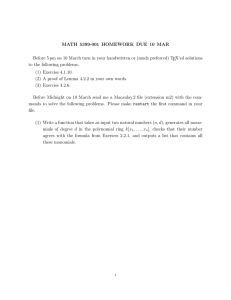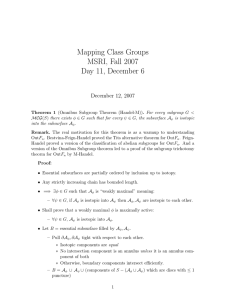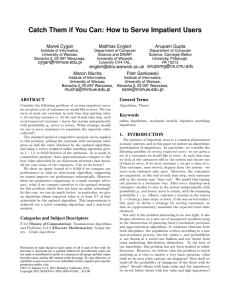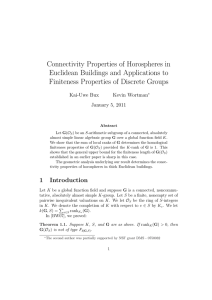ANOTHER ELEMENTARY PROOF OF THE INJECTIVITY OF 1. Overview
advertisement
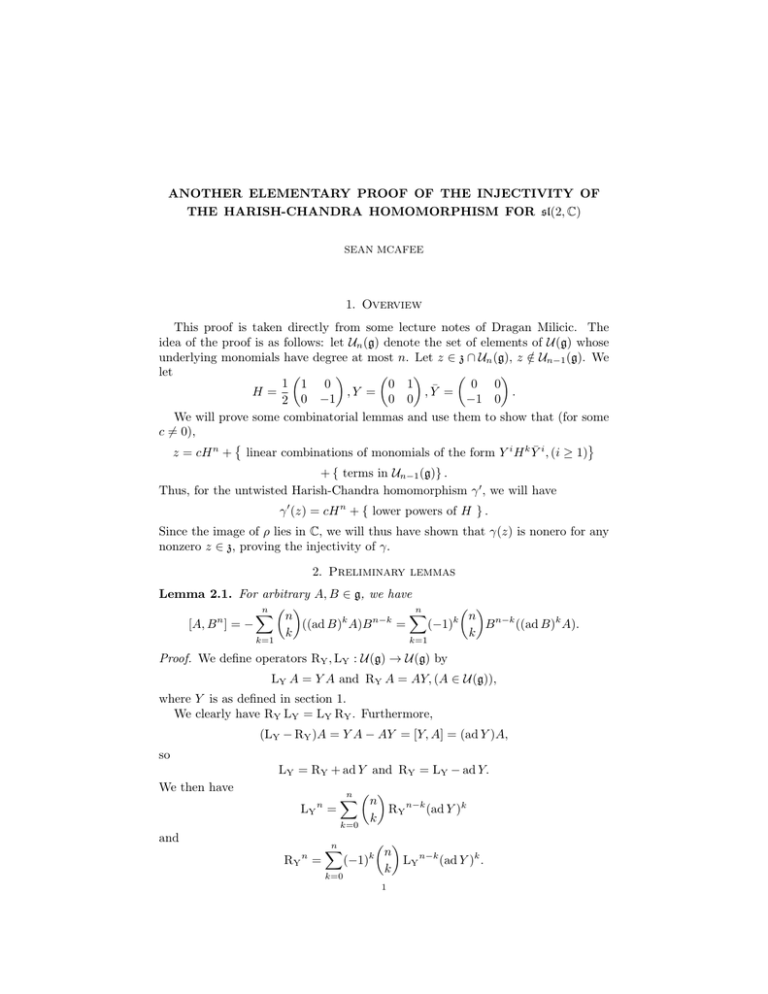
ANOTHER ELEMENTARY PROOF OF THE INJECTIVITY OF
THE HARISH-CHANDRA HOMOMORPHISM FOR sl(2, C)
SEAN MCAFEE
1. Overview
This proof is taken directly from some lecture notes of Dragan Milicic. The
idea of the proof is as follows: let Un (g) denote the set of elements of U(g) whose
underlying monomials have degree at most n. Let z ∈ z ∩ Un (g), z ∈
/ Un−1 (g). We
let
1 1 0
0 1
0 0
H=
,Y =
, Ȳ =
.
0 0
−1 0
2 0 −1
We will prove some combinatorial lemmas and use them to show that (for some
c 6= 0),
z = cH n + linear combinations of monomials of the form Y i H k Ȳ i , (i ≥ 1)
+ { terms in Un−1 (g)} .
Thus, for the untwisted Harish-Chandra homomorphism γ 0 , we will have
γ 0 (z) = cH n + { lower powers of H } .
Since the image of ρ lies in C, we will thus have shown that γ(z) is nonero for any
nonzero z ∈ z, proving the injectivity of γ.
2. Preliminary lemmas
Lemma 2.1. For arbitrary A, B ∈ g, we have
n
n X
X
n
k n
k
n−k
n
(−1)
B n−k ((ad B)k A).
((ad B) A)B
=
[A, B ] = −
k
k
k=1
k=1
Proof. We define operators RY , LY : U(g) → U(g) by
LY A = Y A and RY A = AY, (A ∈ U(g)),
where Y is as defined in section 1.
We clearly have RY LY = LY RY . Furthermore,
(LY − RY )A = Y A − AY = [Y, A] = (ad Y )A,
so
LY = RY + ad Y and RY = LY − ad Y.
We then have
n
LY =
n X
n
k=0
and
n
RY =
n
X
k
RY n−k (ad Y )k
n
(−1)
LY n−k (ad Y )k .
k
k
k=0
1
2
SEAN MCAFEE
This gives us (for A ∈ U(g))
[A, Y n ] = AY n − Y n A = RY n (A) − Y n A
=
X
n
n
n−k
k
(−1)
Y
((ad Y ) A) − Y n A
k
k
k=0
=
n
X
(−1)k
k=1
n
Y n−k ((ad Y )k A),
k
and
n
n
[A, Y ] = AY −
n X
n
k=0
=−
k
RY n−k (ad Y )k (A)
n X
k=1
n
((ad Y )k A)Y n−k ,
k
as needed.
Observe that
(ad Ȳ )Y = [Ȳ , Y ] = 2H,
(ad Ȳ )2 Y = [Ȳ , 2H] = 2Ȳ , and
(ad Ȳ )k Y = 0 for k ≥ 3.
Combining this result with the above lemma gives
[Y, Ȳ n ] = −(2nH Ȳ n−1 + n(n − 1)Ȳ n−1 ).
For future use, we also note that [H, Y ] = Y and calculate
n
n
X
X
n
n
[Y, H n ] =
(−1)k
H n−k ((ad H)k Y ) =
(−1)k
H n−k Y.
k
k
k=1
k=1
Lemma 2.2. Let X1 , ..., Xn ∈ g, and let σ ∈ Sn . Then
X1 X2 · · · Xn − Xσ(1) Xσ(2) · · · Xσ(n) ∈ Un−1 (g).
Proof. First, observe that
X1 · · · Xi Xi+1 · · · Xn − X1 · · · Xi+1 Xi · · · Xn = X1 · · · [Xi , Xi+1 ] · · · Xn ∈ Un−1 (g).
Thus, the lemma holds for any transposition in Sn . Now, suppose that σ and τ are
any two permutations in Sn for which the lemma holds. We have
X1 · · · Xn − X(στ )(1) · · · X(στ )(n)
= (X1 · · · Xn − Xτ (1) · · · Xτ (n) ) + (Xτ (1) · · · Xτ (n) − X(στ )(1) · · · X(στ )(n) ) ∈ Un−1 (g).
Therefore, the set of permutations for which the lemma holds is a subgroup of
Sn . Since the lemma holds for transpositions (which generate Sn ), the proof is
complete.
3
3. proof of injectivity
We are ready to prove the injectivity of the Harish-Chandra homomorphism. As
mentioned in the first section, we let z ∈ z ∩ Un (g) such that z ∈
/ Un−1 (g) and
z 6= 0. We show that γ(z) 6= 0, thus γ is injective. Using Y, H, and Ȳ as a basis for
SL(2, R), we have by Poincaré-Birkhoff-Witt that
X
z=
ciji Y i H j Ȳ i , (i, j ∈ Z≥0 , i + j + i ≤ n)
Note that the exponents of Y and Ȳ are equal in any given monomial term of z.
This is because z is a zero weight of the adjoint representation of U(g).
We let
j0 = max {j ∈ Z≥0 |ciji 6= 0 and 2i + j = n} .
Such a j0 exists since z ∈
/ Un−1 (g).
We now apply the lemmata and observations from section 2 to arrive at the
following series of congruences:
X
0 = [Y, z] ≡
ciji [Y, Y i H j Ȳ i ] mod Un−1 (g)
2i+j=n
=
X
ciji (Y i [Y, H j ]Ȳ i + Y i H j [Y, Ȳ i ])
2i+j=n
≡
X
ciji (−jY i+1 H j−1 Ȳ i − 2iY i H j+1 Ȳ i−1 )
mod Un−1 (g)
2i+j=n
≡ −2i0 · ci0 j0 i0 (Y i0 H j0 +1 Ȳ i0 −1 ) modulo terms involving lower powers of H.
By hypothesis, ci0 j0 i0 6= 0, so the above implies that i0 = 0, thus j0 = n.
Therefore,
z = c0n0 H n + { other terms } ,
so
γ(z) = c0n0 H n + {lower powers of H} − ρ( multiples of some powers of H ) 6= 0,
hence γ is injective, as claimed.







